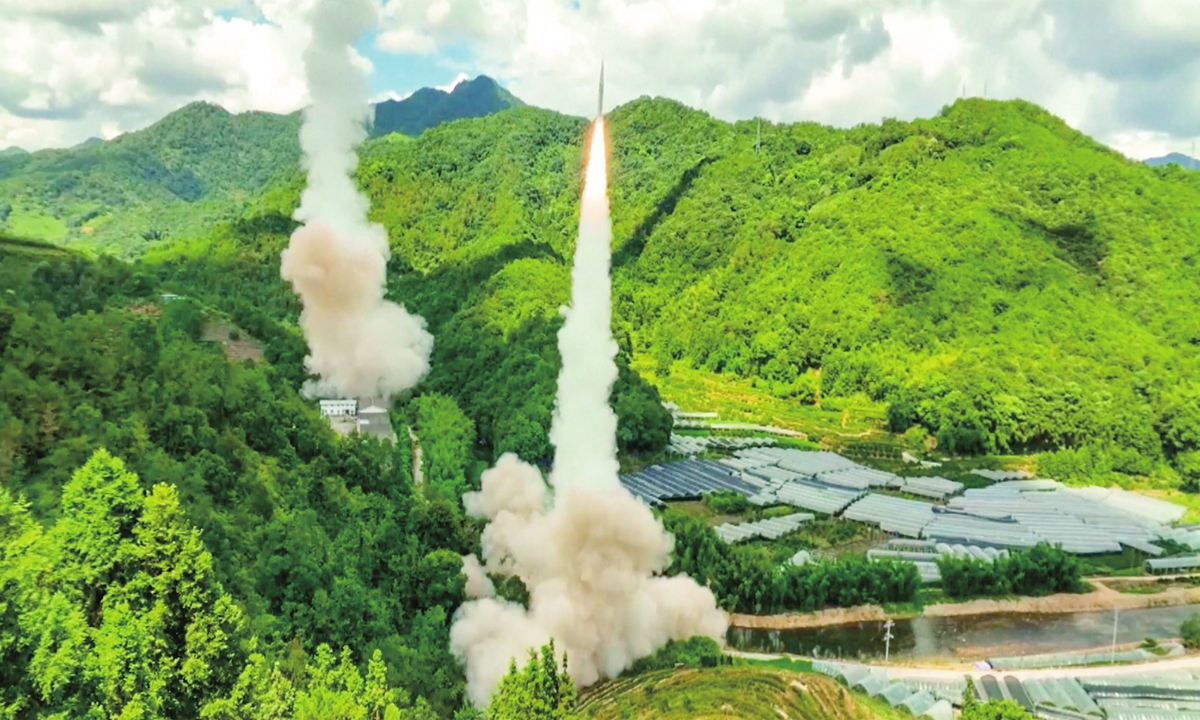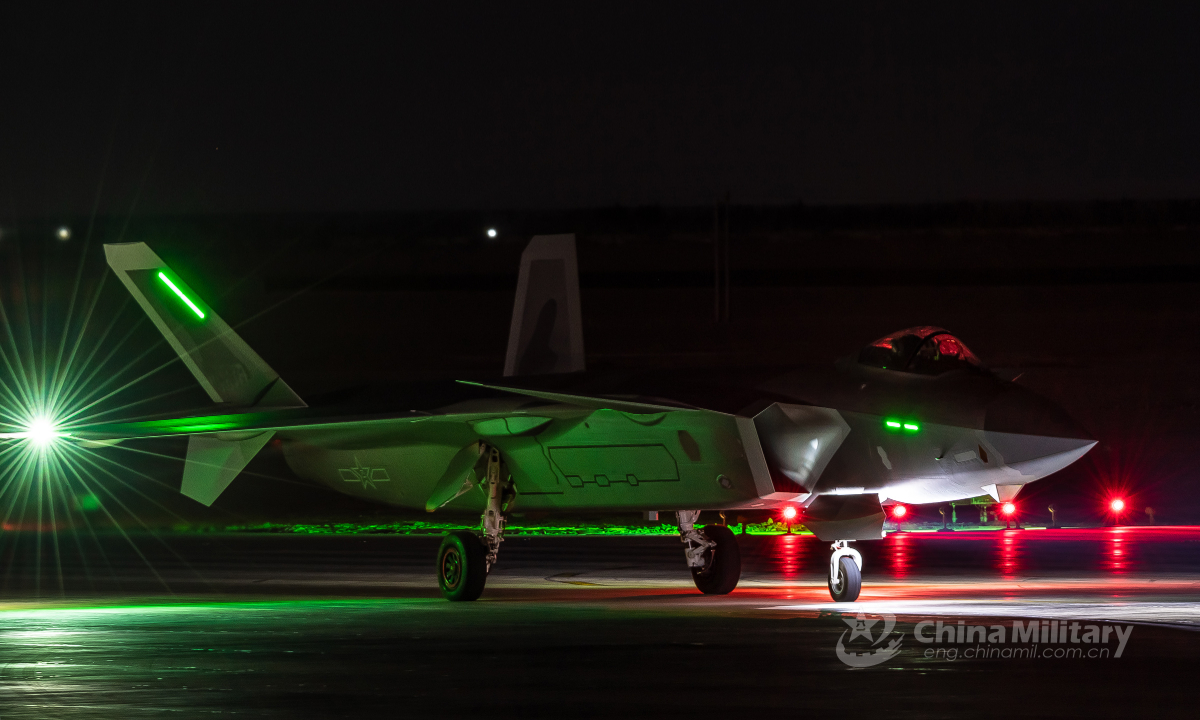
The PLA Eastern Theater Command Rocket Force launches live-fire assaults with multiple types of conventional missiles at several designated sea areas to the east of Taiwan island on August 4, 2022. Photo: IC
The Chinese People's Liberation Army (PLA) on Thursday commenced the second phase of its large-scale military exercises that completely locked down the island of Taiwan, and began to use live fire following the first phase of preparations starting Tuesday evening when US House Speaker Nancy Pelosi visited the island, seriously violating China's sovereignty.
Surrounding Taiwan island with six large maritime areas and its airspace in its north, northeast, east, south, southwest and northwest from Thursday noon to Sunday noon, the unprecedented drills featured advanced weapons, including long-range rocket artillery, anti-ship ballistic missiles, stealth fighter jets and an aircraft carrier group with a nuclear-powered submarine, as well as realistic tactics that simulated a real reunification-by-force operation, demonstrating and honing the PLA's capabilities to not only take over the island, but also prevent any external interference including from the US, experts said.
After the drills kicked off at 12:00 noon, the PLA Eastern Theater Command announced in a press release that the Army conducted long-range artillery live-fire shooting drills in the Taiwan Straits at about 1:00 pm, accurately striking specific targets in the eastern side of the Straits, and obtaining the expected outcome.
Video clips taken by netizens soon circulated on social media showing that long-range rockets were fired from Pingtan, East China's Fujian Province, only 125 kilometers away from the island of Taiwan.
Official video reports by China Central Television (CCTV) show that the PLA's latest long-range multiple-launch rocket systems, allegedly named the PHL-191, were deployed.
With a range of more than 300 kilometers, long-range rockets can easily cover targets on Taiwan island from the Chinese mainland, Song Zhongping, a Chinese mainland military expert and TV commentator, told the Global Times.
Long-range rocket strikes could be one of the first moves in a potential reunification-by-force operation, as the low-cost weapons can be launched in mass numbers from the mainland across the Taiwan Straits to destroy hostile military facilities including air defense installations, radar systems, airfields, bases and command centers with precision, creating advantages for upcoming operations by PLA warplanes and warships, a Beijing-based military expert who requested anonymity told the Global Times.
In the afternoon, the Rocket Force of the PLA Eastern Theater Command launched fire assaults with multiple types of conventional missiles at several designated sea areas to the east of Taiwan island, Senior Colonel Shi Yi, spokesperson of the PLA Eastern Theater Command, said in a statement.
A video released by CCTV shows that one of the missile types featured in the drills is the DF-15, and that the missiles landed in exercise zones in the northeast, east and south of Taiwan island.
This means that the missiles, likely fired from the Chinese mainland, have flown over the sky above the island of Taiwan, observers said.
All missiles accurately hit their targets, proving their precision strike and area denial capabilities and marking the success of the live-fire training mission, Shi said.
Area denial is a concept that describes denying external forces to interfere within a specific area. In this context, it means that the PLA's conventional missile launches practiced hitting foreign aircraft carriers that could intervene from the Philippine Sea in a possible reunification-by-force operation, experts said.
The missiles, which are more powerful than long-range rockets, can also hit targets on the island, analysts said.
A number of PLA conventional missiles, including the DF-21, DF-26 and the hypersonic DF-17, can hit moving targets at sea, observers said.
In addition to the Army and the Rocket Force, the Navy and Air Force also conducted joint military operations, with more than 10 destroyers and frigates conducting joint blockades, alert patrols and reconnaissance, and more than a hundred warplanes including fighter jets and bombers conducting joint reconnaissance, air assault and support missions around Taiwan island, media reported.
The J-20 stealth fighter jet and the YU-20 aerial tanker were seen in the report.
The drills also featured the PLA's first aircraft carrier group deterrence exercise, which has established a maritime multidimensional combat system, Zhang Junshe, a senior research fellow at the Naval Research Academy of the PLA, told the Global Times.
"Normally, a nuclear-powered submarine will accompany an aircraft carrier group in its mission," Zhang said. The expert confirmed with the Global Times that at least one nuclear-powered submarine has been deployed.
While the drills are organized by the PLA Eastern Theater Command, forces from other theater commands also participated in the drills, Zhang said. "This reflects the high interoperability between PLA's various theater commands," he said.
The PLA Navy operates two aircraft carriers, the
Liaoning and the
Shandong. Zhang did not confirm which carrier is participating in the drills, or if both carriers have formed a dual-carrier group.
PLA activities not only covered the island of Taiwan, but also Taiwan-administered Kinmen, which is only about 10 kilometers away from the Chinese mainland city of Xiamen, with Taiwan's defense authority reportedly saying that PLA drones were spotted flying over the region for the first time on Wednesday evening.
Pelosi's visit to the island on Tuesday goes against the US' promise not to support "Taiwan independence" forces on the island, Senior Colonel Tan Kefei, spokesperson at China's Ministry of National Defense, said in a statement released on Thursday. "PLA's words count," he said.
The PLA Eastern Theater Command's joint drills around Taiwan island, including live-fire guided precision weapons, are precisely aimed at deterring collusion between the US and the island, Tan said, stressing that any collusion would only push Taiwan island to the abyss of disaster and bring about severe damage to compatriots on the island.
Overall, the drills are very close to Taiwan island. The drill to the northwest of the island is taking place around Pingtan, the narrowest part of the Taiwan Straits. The drill in this area can block the northern channel of the Straits; two other drills to the north of Taiwan can block Keelung Port; the drill to the east of the island directly targets military bases in Hualien and Taitung; the drill to the southeast of the island can effectively threaten the Bashi Channel; the last one to the southwest of the island is very close to Kaohsiung and Zuoying, Zhang said.
"The PLA operations could form a complete blockade around Taiwan island," Zhang said.

A J-20 fighter jet attached to a PLA air force base stands ready on the runway for the upcoming air combat training exercise involving multi-type fighter jets on May 17, 2022. (eng.chinamil.com.cn/Photo by Yang Jun)
Complete blockadeMedia on the island expressed worries not only from a military perspective, but also other fields concerning people's daily life such as energy supplies and flights on the island, as the PLA's drills basically form a three-day blockade of the island.
The drills are expected to affect the transportation and replenishment of natural gas vessels that are vital to power generation in the island. According to local media, natural gas vessels at ports in Taichung and Kaohsiung are currently operating normally, but a local petrochemical energy company has been closely observing the situation and drawn up emergency response plans.
Citing an economic affairs authority in the island, media said that the company has enough oil supplies for 40 days. The total oil stocks of authorities and civilian institutions in the island are enough for 100 days' usage. Fire coal stocks in the island are sufficient for about 30 days, while there are enough natural gas stocks on the island for only 10-11 days.
According to media reports, 18 international air routes and 900 flights scheduled to pass the Taiwan Straits have been reportedly adjusted due to the drills. Airports in the island have canceled 66 flights as of Wednesday because of the drills.
In response to whether the PLA's drills will become a new normal in the Taiwan Straits, Chinese Foreign Ministry Spokesperson Hua Chunying said at a routine press conference on Thursday that it depends on the US and the secessionist forces in Taiwan. "As long as they go on with their secessionist actions, we will not stop displaying our determination to safeguard national sovereignty and territorial integrity," Hua said.
Denying interventionShortly before the PLA exercises on Thursday morning, a US RC-135S ballistic missile detection aircraft flew to the Philippine Sea east of the island of Taiwan, with two aerial tankers following, according to open-source flight tracking data obtained by the Global Times.
The US military likely conducted close-in reconnaissance of the PLA drills, and the US remains the most threatening military force that could interfere in the Taiwan question, observers said.
The PLA exercise zones set in the northeast, east and south of Taiwan island are designated not only to blockade Taiwan and hit targets on the island, but also to prevent external forces like the US from intervening from its bases in Japan and Guam via the Philippine Sea and the Bashi Channel, experts said.
Naval forces deployed in those regions, in addition to land-based anti-ship ballistic missiles like those launched in Thursday's drills, can push the PLA's defense lines against external forces farther away from both the Chinese mainland and the island of Taiwan, the expert said, noting that the drills displayed the PLA's anti-access and area denial capabilities.
Just as the PLA live-fire drills were about to start on Thursday, the US Navy's
Ronald Reagan carrier strike group moved northeast toward its homeport in Yokosuka, Japan, away from the island of Taiwan, an intelligence expert who requested anonymity told the Global Times, citing open-source data.
The US carrier's retreat from the PLA's exercise region after escorting Pelosi's flight fully reflected the PLA's deterrence capabilities, Zhang said.
This is a strong contrast to the Taiwan Straits crisis in 1996, when the US dared to deploy two carriers around Taiwan in an attempt to threaten China, observers said.
The stunning drills are scheduled to continue for two and a half days until Sunday noon.





